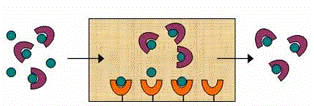Chemistry, Department of: Faculty Series

David Hage Publications
Document Type
Article
Date of this Version
9-2016
Citation
Separations 2016, 3, 27;
doi:10.3390/separations3030027
www.mdpi.com/journal/separations
Abstract
The development of separation methods for the analysis and resolution of chiral drugs and solutes has been an area of ongoing interest in pharmaceutical research. The use of proteins as chiral binding agents in high-performance liquid chromatography (HPLC) has been an approach that has received particular attention in such work. This report provides an overview of proteins that have been used as binding agents to create chiral stationary phases (CSPs) and in the use of chromatographic methods to study these materials and protein-based chiral separations. The supports and methods that have been employed to prepare protein-based CSPs will also be discussed and compared. Specific types of CSPs that are considered include those that employ serum transport proteins (e.g., human serum albumin, bovine serum albumin, and alpha1-acid glycoprotein), enzymes (e.g., penicillin G acylase, cellobiohydrolases, and α-chymotrypsin) or other types of proteins (e.g., ovomucoid, antibodies, and avidin or streptavidin). The properties and applications for each type of protein and CSP will also be discussed in terms of their use in chromatography and chiral separations.


Comments
© 2016 by the authors; licensee MDPI, Basel, Switzerland. This article is an open access article distributed under the terms and conditions of the Creative Commons Attribution (CC-BY)